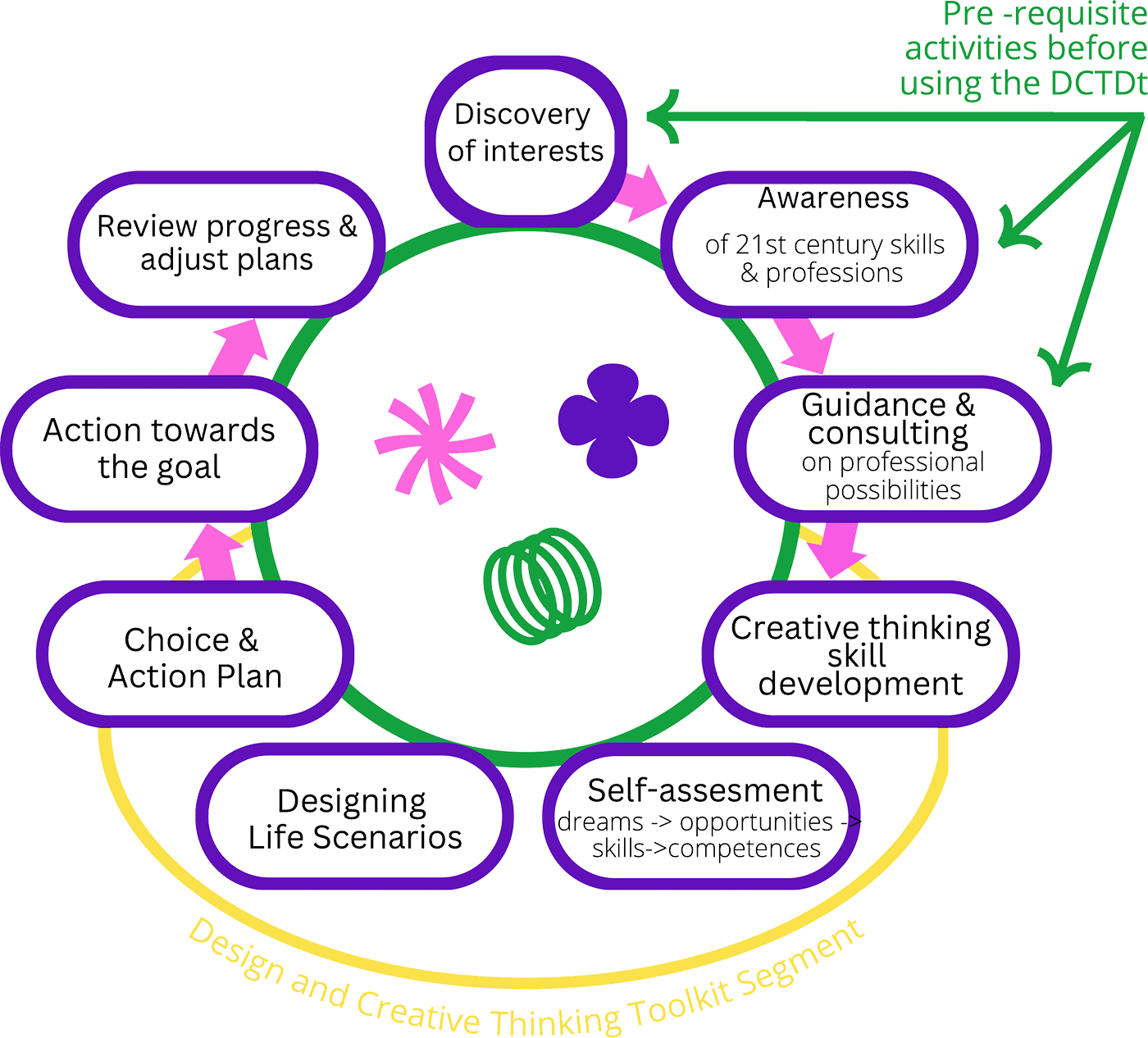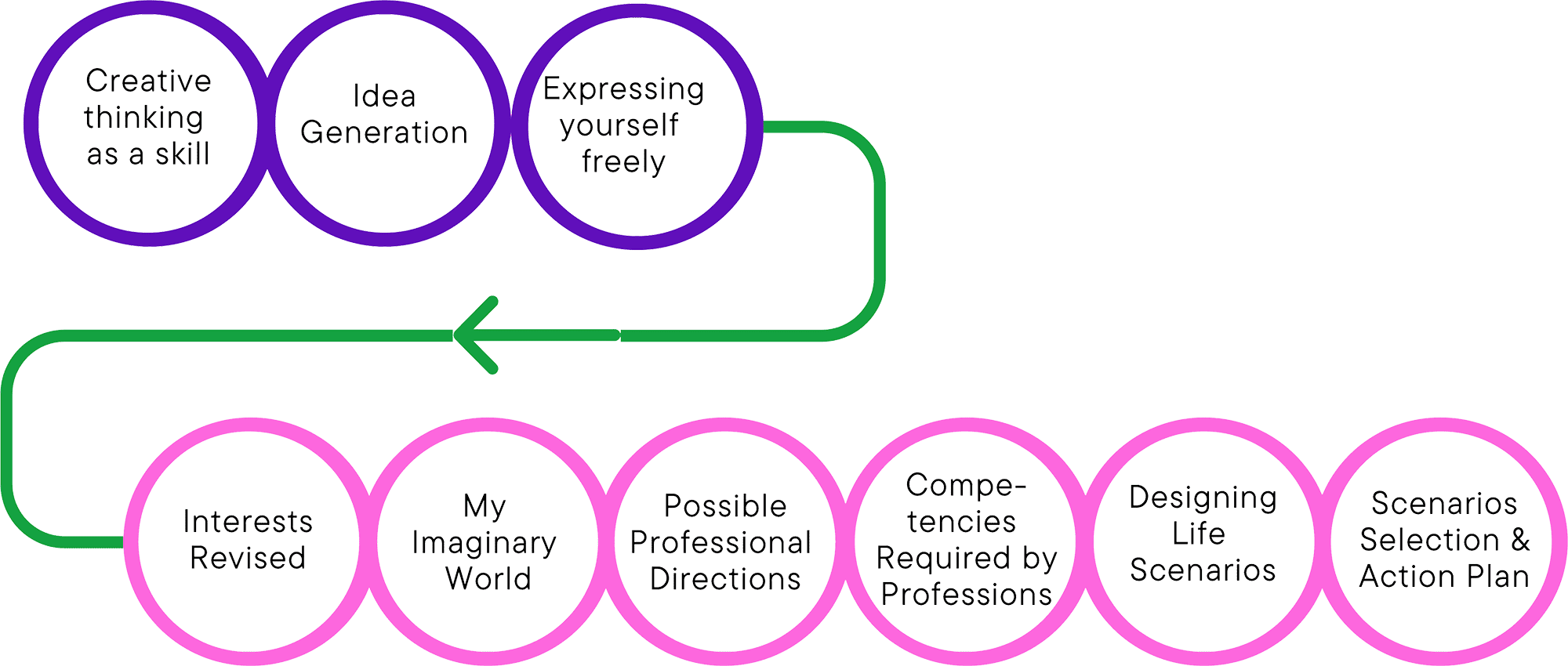Part three –
Developed model
Back to Methodological guide Page
Overview. Developed model
Design and Creative Thinking Development Toolkit is a set of methods and activities. The toolkit consists of nine consecutive steps divided in two parts:
- the first part focuses on understanding and developing the concept of creative thinking skills;
- the second part focuses on the practical application of design and creative thinking skills in the decision-making process.
The toolkit was created with the intention of helping youth to understand how personality traits, interests and abilities can be successfully combined when choosing future professional directions in life. The activities are planned in such a way that the adolescent can design life scenarios in different professional directions, be able to make informed decisions about the growth path after obtaining basic education: continue studies, learn a profession or start working. Awareness of opportunities helps to navigate better complex situations, understand the sequence of events, see non-standard solutions and make alternative choices. Creative and design thinking skills are crucial in this toolkit.

The process involves a set of consecutive stages: first, each participant is asked to evaluate the characteristics of their own personality, talents and interests, and then is encouraged to create a vision of their future life and its quality. Initial step is followed by linking knowledge about professions with one’s own personality, helping the adolescent to identify possible professional directions to express oneself as well as providing the desired level of quality of life. Once three more interesting professional directions have been identified and some essential competencies required by these professions clarified (possessed and to be developed), the process of designing life scenarios begins by visually depicting the result to be achieved and most important things to be done towards it.
The adolescent then chooses top priorities for the near future, and prepares an action plan to get to know selected professions in depth and/or develop the necessary skills, so that after completing basic education, one can successfully continue to progress towards achieving the goals. The methodology provides for regular evaluation of the implementation of the plan with the possibility of changing your choice.

Creative Thinking Skills Development
The first three steps focus on the understanding and practical application of the concept of creative thinking. They will help form an idea of the versatility of creative thinking and develop the components that make up this skill: critical thinking, flexibility, freedom, originality, etc.
Designing Life Scenarios
Steps 4 through 9 if accomplished sequentially highlight personality traits, interests, and skills, help to model ideal life paths, and professional opportunities in order to demonstrate that all above mentioned entities interact as variables in designing life scenarios.
Each part of the developed model is important and has some specific aims which in details are described in the Toolkit which can be found here: https://creativethinkingtoolkit.com/toolkit//
1. Possible scenarios on how the Toolkit can be used
As already mentioned above, Design & Creative Thinking Development Toolkit “Designing Life Scenarios” was created with the intention of helping young people to understand how personality traits, interests and abilities can be successfully combined when choosing future professional directions in life. The Toolkit is a set of methods and tools and consists of nine consecutive stages, divided into two parts: the first part focuses on understanding and developing the concept of creative thinking skills; the second part focuses on the practical application of design and creative thinking skills in the decision-making process.
In order to ensure the achievement of the goal that youngsters are able to design their life scenarios and professional directions, to make balanced and thoughtful decisions about the growth path after obtaining basic education and to make alternative choices, the developers of the toolkit recommend organising activities according to the described plan and sequentially implementing all 9 stages of both parts. When choosing the methods and activities that were included in the toolkit, both the long-term experience of the project participants in working with young people and non-formal education activities, as well as the recommendations of youth workers from Latvia, Estonia and Denmark were taken into account. The total time required fo quality implementation of all stages is at least 12 hours.
How to implement the activities?
Activities can be implemented according to several scenarios:
- 1. As two-day classes, devoting 6 hours to each day. Recommended action plan:

- 2. Organize long-term activities for young people, for example by meeting once a week and implementing one activity at each meeting. The implementation of such a scenario will require 12 meetings/weeks.
- 3. Organize a “Designing Life Scenarios” camp for young people, in which all activities will be carried out over several days, incl. paying in-depth attention to those lessons that young people need more time to learn. Both using new methods and devoting more time to implementing the recommended methods.
Tips for facilitators
- If other activities have been implemented with young people previously, the purpose of which is similar to the one indicated in the tool, for example, reviewing interests, then individual activities may not be implemented according to the plan, however, we would like to emphasize that the sequence is essential in using the developed tool, so we recommend sticking to the plan.
- Be creative and if you know other methods that can help you achieve the desired goal, feel free to change methods and use those that you have already tested in your practice and that have proven themselves.
- If more time is available, spend more time on each step, both by slowing down and repeating activities.
- Apply the methods to the young people you work with. It is possible that a young person will need a more individualised approach and will need additional explanations.
- Don’t forget to arrange for the participants to get to know each other (if they haven’t known each other before). Introduce yourself and/or other facilitators. If necessary, organize some “getting to know each other” games.
- Explain how much time the activities will take, and what is going to happen during them. Highlight the importance or the respect for each other and that there are no wrong or right answers.
- Observe participants and if energy level is down, offer short breaks during classes and offer drinks and snacks to the youth.
- Think carefully and prepare all the necessary materials in advance – writing papers, printouts of worksheets, etc.
- Prepare yourself for activities but be also ready for unexpected situations. at such times that you can use your creative potential!
2. What to do further and how to support youngsters
We believe that you, as a leader of the activities, managed perfectly to conduct all the activities of all 9 steps, which revealed a lot to the young people about themselves and better also revealed their future life scenarios. However, every finish is the beginning of something new and it is important to continue what has been started. Going forward, young people will definitely need your continued support.
Moving towards the goal
The action plan needs to be active, so make sure it doesn’t stay on paper. It is valuable for a young person to know that help, guidance and encouragement are available. Invite young people to involve the people around them – family members, friends, youth workers and/or other youth support persons on the way to the realisation of their goal. It is possible that the young person can be assigned a mentor who will regularly communicate with the youngster, inspire and motivate them, provide some practical help or simply ask:
how are you? how are things on the way to the planned? are you getting closer to your goal etc?
Remind the youngster that various obstacles may also need to be overcome in order to achieve the goal. Invite young people to implement the five-step rule in their everyday life!
- Plan what you can do every month to get closer to your goal!
- Plan what you can do each week to get closer to your goal!
- Plan what you can do every day to get closer to your goal!
- Think about what you can do today!
- Every day, write down at least five things that you commit to do to get closer to your big goal!
Small things to support young people in achieving their goals:
- regular meetings (agree with the youngster on their frequency, form, type);
- messages of reminder, encouragement, inspiration, which can be sent to the youngster from time to time;
- if the young person visits the youth center, post some motivational messages on the walls;
- organize additional activities, such as trainings about goals achievement;
- invite a person who inspires youngsters to tell about their personal experience in achieving goals;
- invite young people to create a mutual support system/group and help organise regular meetings.
Review progress & adjust plans
It is advisable to set some evaluation criteria and timeframe to review achievements and, if necessary, corrective actions. Yes, plans can change, or just part of them and adolescents need constant support to stay curious. Mastering design and creative thinking helps to adapt quickly to new circumstances and to seek unconventional solutions. Motivate the young person not to give up in case something fails.
“Start from where you are. Use what you have. And do what you can do! “
Professional tennis player Arthur Ashe
3.Useful links and support materials
Here are some links where it is possible to find some additional resources and materials that could help working with youth on the topic of creativity, personal growth and professional directions. Information is divided by countries as different languages in each of them are used.
Latvia
Estonia
- https://minukarjaar.ee/et/karjaar/karjaaritee/tuleviku-karjaarikusimus-opilane?selectedCardTitle=Ei%20tea,%20mida%20teha%3F
- https://sites.google.com/view/tooriistakast/avaleht?authuser=0&pli=1
- https://www.sm.ee/et/noortegarantii
- https://mitteformaalne.ee/opimeetodid/
- https://rajaleidja.ee/juhendid/
- https://www.hm.ee/ministeerium-uudised-ja-kontakt/ministeerium/strateegilised-alusdokumendid-ja-programmid#noortevaldkonna-aren
